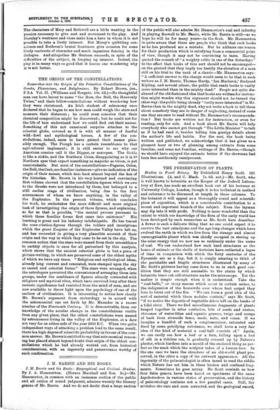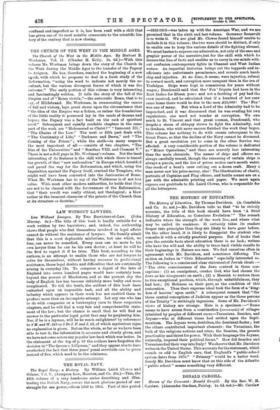THE PRESERVATION OF PLANTS.
Studies in Fossil Botany. By Dukinfiold Henry Scott. 161 Illustrations. (A. and C. Black. is. net.)—Mr. Scott, who is well known to botanists as the Keeper of the Jodrell Labora- tory at Kew, has made an excellent book out of his lectures at University College, London, though it is too technical in method and substance to be discussed at length in these columns. To the botanist it will appeal as a thoroughly sound and scientific piece of exposition, which is a considerable contribution to a recent and important branch of the subject. Even the layman may dip into it with profit. Nothing is more wonderful than the extent to which our knowledge of the flora of the early world has been developed by such researches as Mr. Scott here describes. A flower is buch a delicate thing that no one could expect it to survive the vast cataclysms and the age-long changes which have evolved the earth in which we live from the strange and almost unrecognisable planet which was chiefly occupied in storing up the solar energy that we now use so recklessly under the name of coal. We can understand how such hard structures as the bones of animals or the shells of tortoises have outlasted a lapse of time in comparison with which the forty centuries of the Pyramids are as a day, but it is simply amazing to think of the perishable and fragile structures illustrated by many of Mr. Scott's pictures having come down to us in such good con- dition that they are still amenable to the stains by which botanists trace out cell-structure under the microscope. Yet the matter is simple enough when it is understood. Take the "coal-balls," or stony masses which occur in certain mines, to the indignation of the housewife over whose best carpet they love to burst out of the fire. "We can form a good idea of the sort of material which these nodules contain," says Mr. Scott, "if we notice the deposits of vegetable debris left on the banks of a tidal river. There we find miscellaneous fragments of plants heaped together in utter confusion, bits of reeds and rushes, rhizomes of water-lilies and aquatic grasses, twigs and scraps of bark from riverside trees, seeds, nuts, and cones. If we imagine a handful of such a conglomeration, saturated and fixed by some petrifying substance, we shall have a very fair idea cf the kind of material a coal-ball consists of." Again, we can easily see how a leaf or a fern, falling upon a bed of silt in a tideless sea, is gradually covered up by Nature's plaster, which hardens into a mould of the enclosed thing as per- fect as the mask which the sculptor takes of a human face. In the one case we have the structure of an old-world plant pre- served, in the other a copy of its outward appearance. All the ingenuity of the palceontologist is often taxed to read the riddle which Nature has set him in these broken and confused frag- ments. Sometimes he goes astray. Mr. Scott reminds us how four false genera have been based on specimens of the same Lepidodendron in various states of preservation, and the history of palmontology contains not a few parallel cases. Still, the mistakes ttre rare and soon corrected, and the geological record,
confused and imperfect as it is, has been read with a skill that has given one of its most notable ornaments to the scientific his- tory of the century that is now closing.



















































 Previous page
Previous page